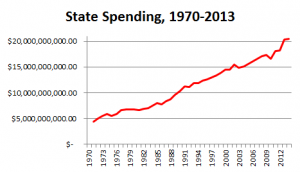
State spending has increased 368 percent since 1970, a number which can be expected to grow even more as Governor Malloy seeks greater spending in the upcoming budget.
Connecticut has a spending problem.
Since 1970, state expenditures have increased an inflation-adjusted 368 percent, a figure which does not include the additional spending increases Governor Malloy is expected to announce at noon today. Reuters predicted February 1st that the total budget deficit for FY2013 would equal $140 million.
The state’s debt to GDP ratio, according to Barron’s “State of the States” report, is 7.9 percent, second to only Hawaii (with an easily attainable 8.0 percent) and well beyond the national average. When unfunded pension liabilities are added to the equation, Connecticut’s spending tops the list at 17.1 percent of GDP. In other words, Connecticut has the heaviest debt burden in the nation.
The most important
indication of the problem, however, is the fact that we can’t stop spending. Governor Malloy has recently announced, in the words of the Hartford Courant, “a bold plan to spend $2 billion” to expand the University of Connecticut. Some might argue that, given the state’s budget situation, this plan is not exactly the ‘good’ kind of bold.
More revealing is the Governor’s budget proposal, set to be revealed later today, which the Associated Press says will cut $1.8 billion from the amount of legally required spending while simultaneously raising general fund spending a combined 8.7 percent over the next two years. Malloy is not exactly reducing deficits, then, as the FY2014 budget will likely increase to $20.8 billion.
Given the reckless nature of state and national spending it should come as no surprise that the Corporation for Enterprise Development’s annual Assets & Opportunity Scorecard found the personal finances of Connecticut citizens to be abysmal.
The report found that 37 percent of Connecticut families are “liquid asset poor”, lacking enough savings to sustain themselves for three months during an emergency. This figure represents a 12 percent increase from 2012.
Many of these families can blame their liquidity issues on spending problems, given that Connecticut also boasts the nation’s highest average credit card debt at $15,028. The national average is $10,736.
The clever citizen does not have to think very long to see the connection between state and individual spending; both are increasing at reckless and unsustainable levels. And, if individuals continue to follow the lead of their big brother Dannel, personal spending will only increase in the face of budget shortfalls.
Perhaps it is time that government, and Connecticut residents, learn to say “no” to the latest and greatest deal. Such restraint is truly the only way to get our collective finances in order.
